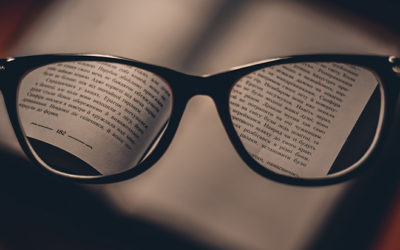Blue in the face – the problem with too much blue light
As a society constantly glued to our digital devices, we need to know and understand the effects of too much exposure to Light Emitting Diode (LED) back-light technology. Yes, the technology helps to enhance screen brightness and clarity, but it also emits very strong blue light waves.
Think about all the LED devices we use – cell phones, computers, tablets and flat-screen televisions are just a few. Due to their widespread and increasing use, we are gradually being exposed to more and more sources of blue light and for longer periods of time.

But what is blue light?
Light of all kinds are produced in wavelengths. It starts with the shortest wavelengths, ultraviolet light, and runs through the visible spectrum of light and into infrared. As in the rainbow, blue light comes after ultraviolet and has the shortest wavelength of visible light. It is produced naturally by the sun and artificially by electronic light, such as LEDs.
The human eye, however, is only sensitive to one part of this spectrum: visible light. Visible light is that part of the electromagnetic spectrum that is seen as colours: violet, blue, green, yellow, orange and red.
Repeated exposure to the blue end of the light spectrum can cause serious long-term damage to your eyes.
And blue light can affect us when outdoors?
Blue light is everywhere.
When outside, light from the sun travels through the atmosphere. The shorter, high energy blue wavelengths collide with the air molecules causing blue light to scatter everywhere.
In its natural form, blue light is actually beneficial as it matches up with your body’s expectations — your body uses blue light from the sun to regulate your natural sleep and wake cycles. This is known as your circadian rhythm.
During applicable times of the day, as well as appropriate durations of exposure, blue light can also boost alertness, elevate mood and support memory and cognitive functions.
So what are the harmful effects of blue light?
While blue light can help elevate your mood and boost awareness, continuous exposure to blue light at night can lower the production of melatonin — the hormone that regulates sleep — and disrupt your circadian rhythm. Further, blue light can cause:
- A greater risk of certain types of cancer
- A greater risk of diabetes, heart disease and obesity
- An Increased risk of depression
This is perhaps why working the night shift is referred to “the graveyard shift”. Harvard researchers have linked working the night shift and exposure to blue light at night to several types of cancer (such as breast and prostate), diabetes, heart disease, and obesity as well as an increased risk for depression.
Blue light can also lead to:
Digital eye strain
Digital eye strain, or computer vision syndrome, is a medical issue with serious symptoms that can affect work productivity. Affecting 50 to 90% of people who sit and work in front of computers all day, digital eye strain has overtaken carpal-tunnel syndrome as the number one computer-related complaint.
Symptoms include:
- Blurry vision
- Difficulty focusing
- Dry and irritated eyes
- Headaches
- Neck and back pain
But digital eye strain does not just affect adults. Children are also at risk for eyestrain due to their increasing use of digital devices.
Did you know that children and teenagers spend more than 7 hours per day consuming electronic media? According to a study conducted by Kaiser Family Foundation, children’s eyes are not fully developed before the age of 10. The crystalline lens and cornea are still largely transparent and overexposed to light – so too much exposure to blue light can be quite detrimental.
Parents are urged to monitor and limit the amount of screen time their children are permitted.
Here are some other tips you can try in the office (or at home) to avoid eye strain:
- Adjust the brightness of your digital screen
- Clean your screen
- Increase text size
- Limit the amount of screen time
- Step away – take a break from the screen
- Blink more
Age-related macular degeneration
Dr. Michael Tolentino, considered by many in the industry to be the foremost medical authority on macular degeneration, states that the retina can be harmed by high-energy visible radiation of blue light that penetrates the macular pigment found in the eye.
A low macular pigment density may represent a risk factor for age-related macular degeneration by permitting greater blue light damage to the retina.
Chronic exposure to blue light can lead to long range growth in the number of macular degenerations, glaucomas, and retinal degenerative diseases.
What can I do to prevent overexposure to blue light?
Protective eye wear
Both indoors and outdoors, protective eye wear can significantly improve symptoms of blue light overexposure and boost visual performances in situations with low contrast.
Indoor eye wear, or office glasses, are designed to reflect and cut high energy blue light penetration. Sunglasses that are tinted or polarized to absorb the blue rays are perfect for outdoors during the day.
Click here to see our protective eye wear range
Additionally, Apple has just released a blue light filter in their latest iOS update for iPhones and iPads.
Everyone needs to take precautions against the effects of blue light.
Chances are that most of us spend many hours staring at a computer screen or texting on our cell phones — we are all being exposed to blue light. Please take the necessary steps into looking after your eyes.
Have you experienced any blue light effects? Do you need support in moderating your blue light exposure? Email Jenny at jenny@gp-optom.co.nz and we can book an appointment.
Featured Posts
Concussion and Vision: What You Need to Know
The long-term implications of concussion have been in the news a bit lately, connected with playing rugby. While concussions (especially repeat concussions) have a number of…
Everything You Need to Know About Myopia
The term ‘myopia’ might sound scary, but it’s simply the medical term for shortsightedness, or nearsightedness. If you have myopic vision, you will be able to…
Address
Cnr Great South Road & Rockfield Road, Greenlane 1051
Phone
09 525 1516
Hours
Mon to Fri: 9am – 5pm
Sat to Sun: Closed
Holidays: Closed



